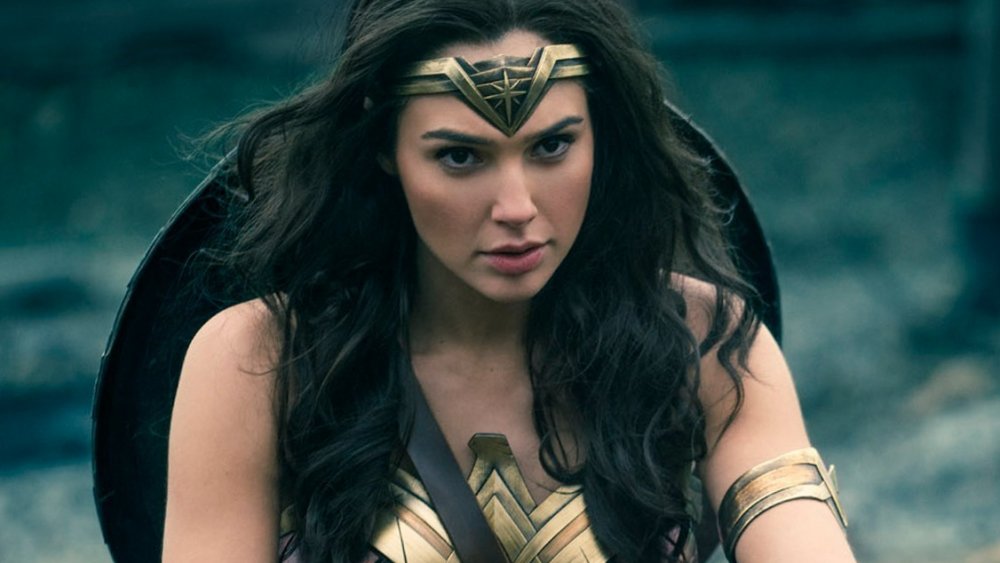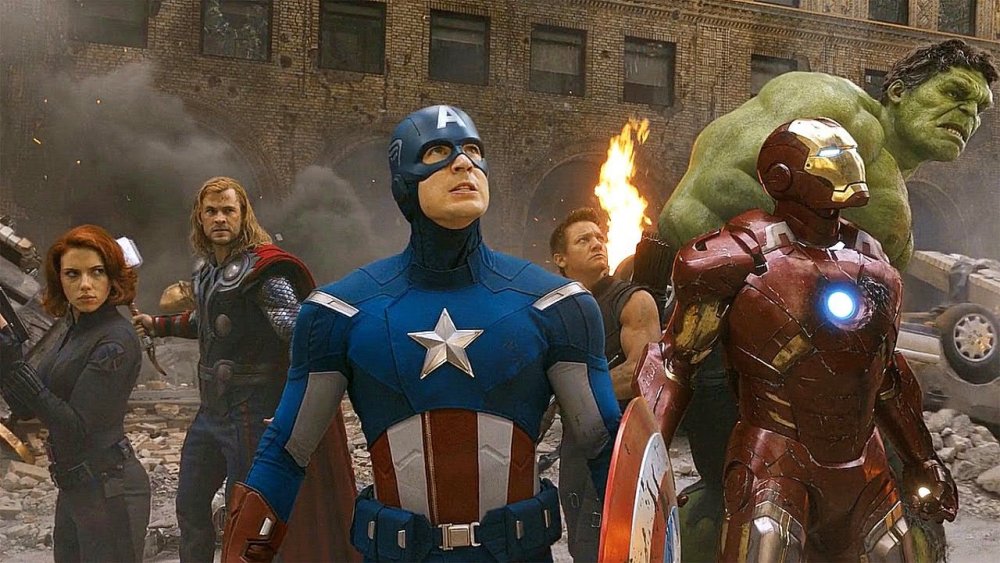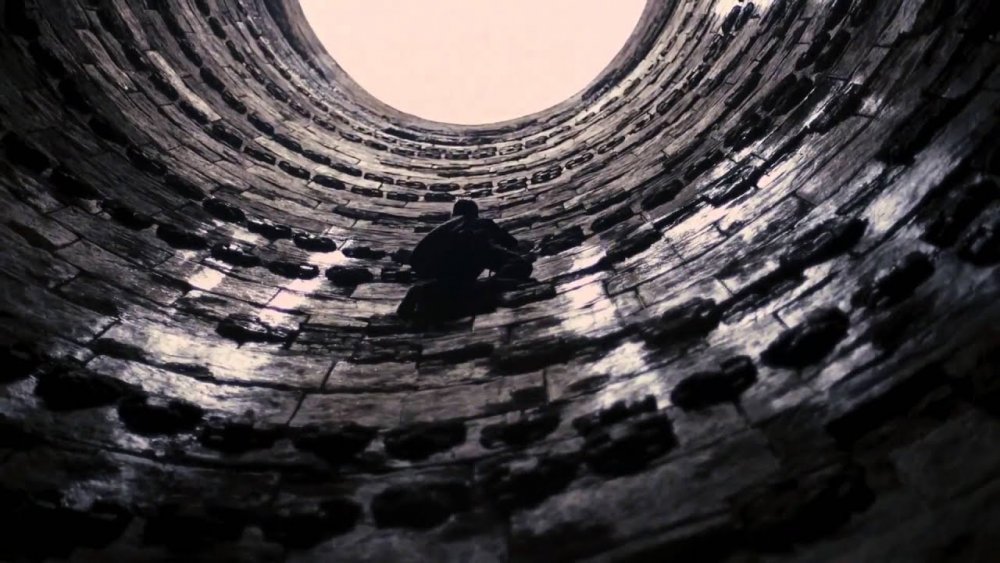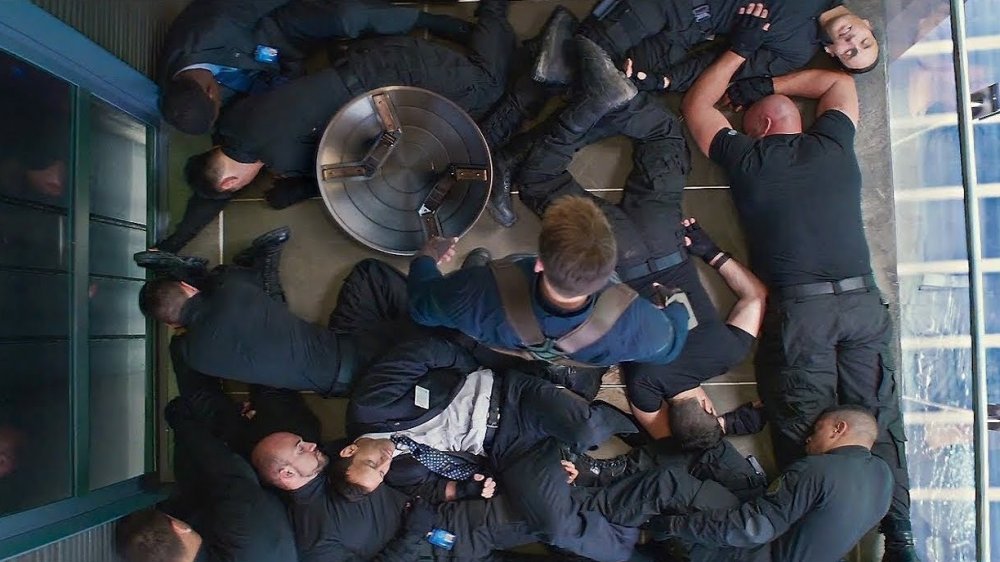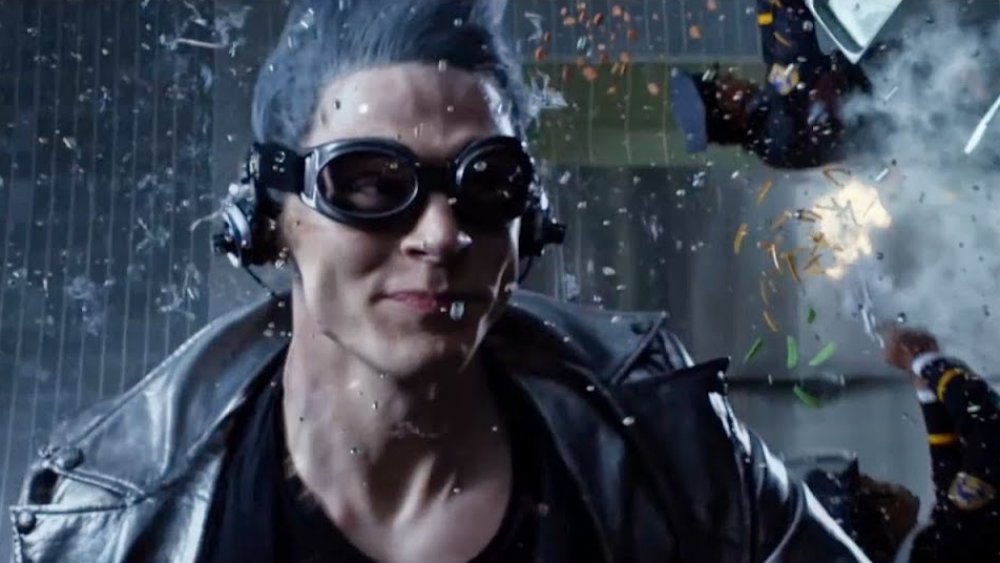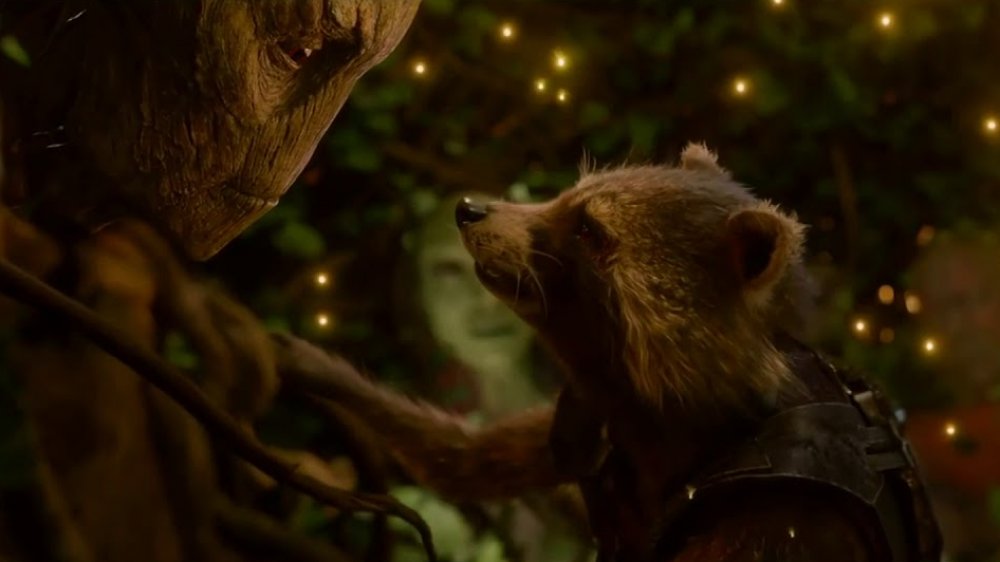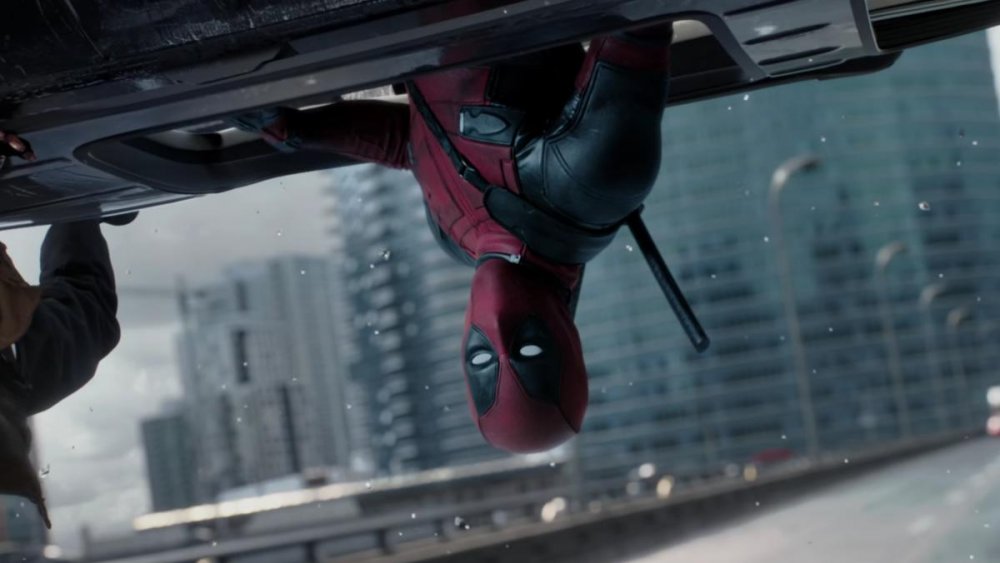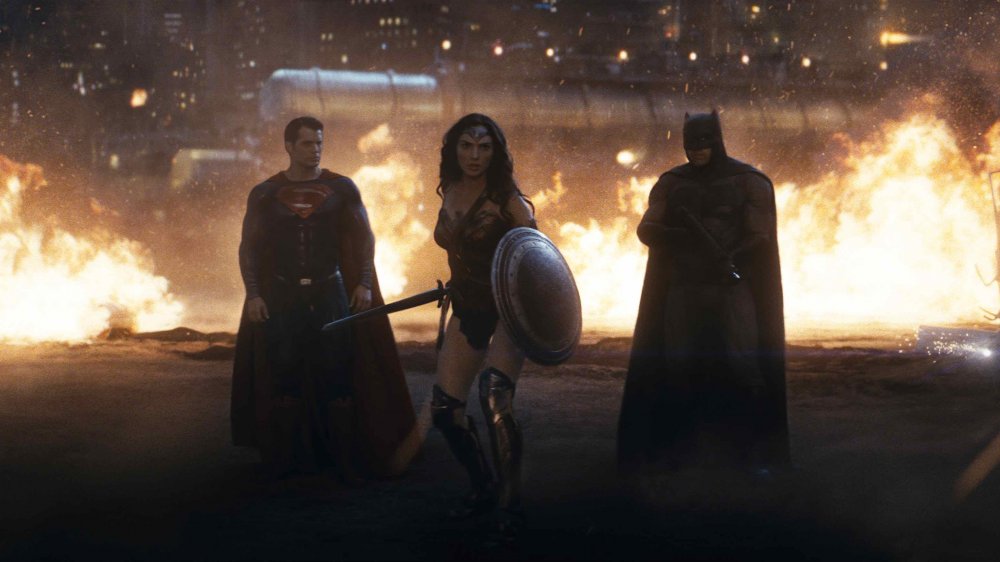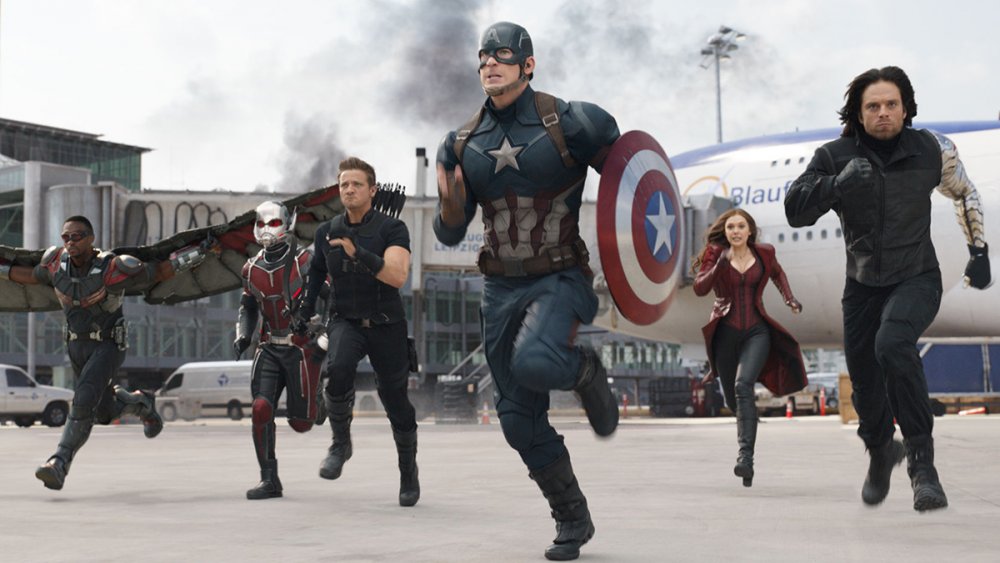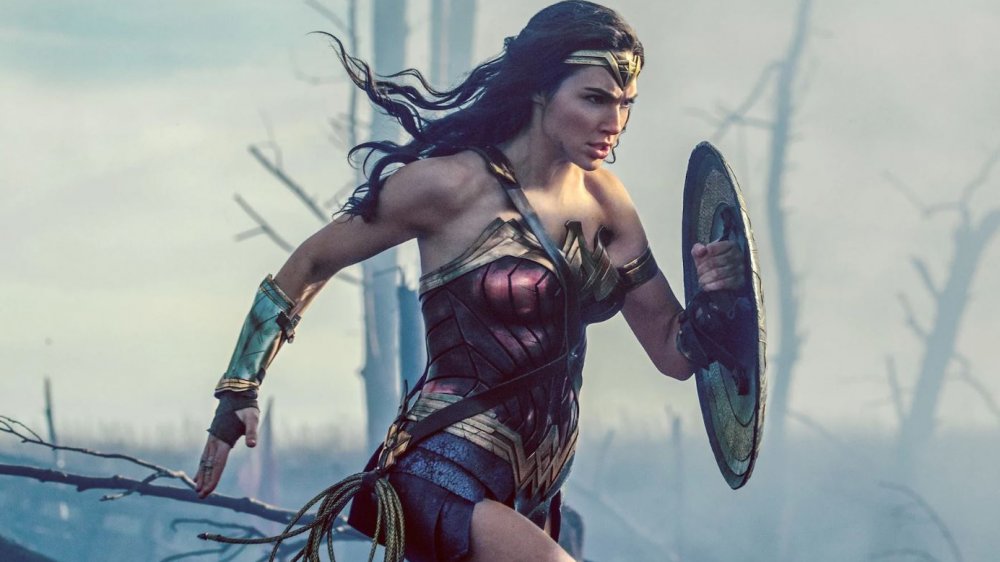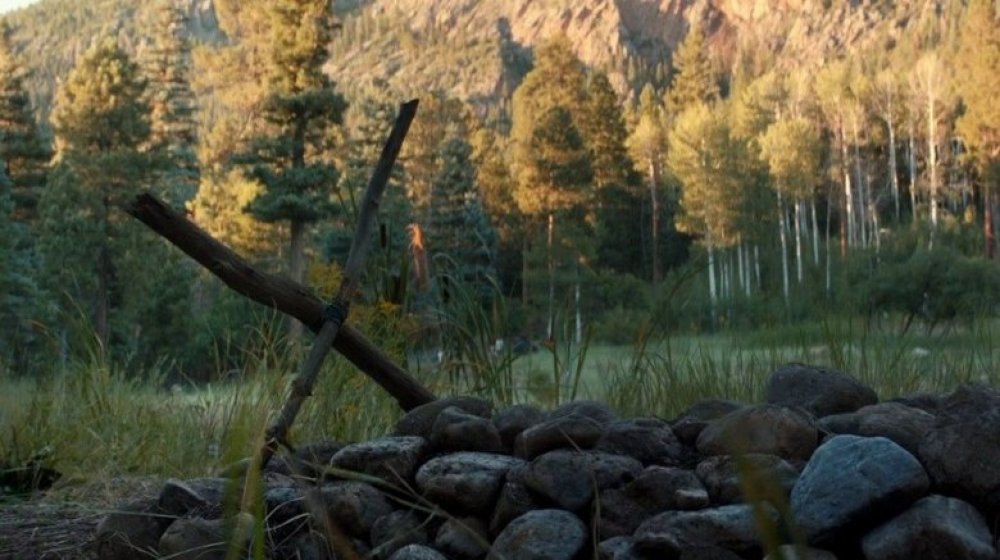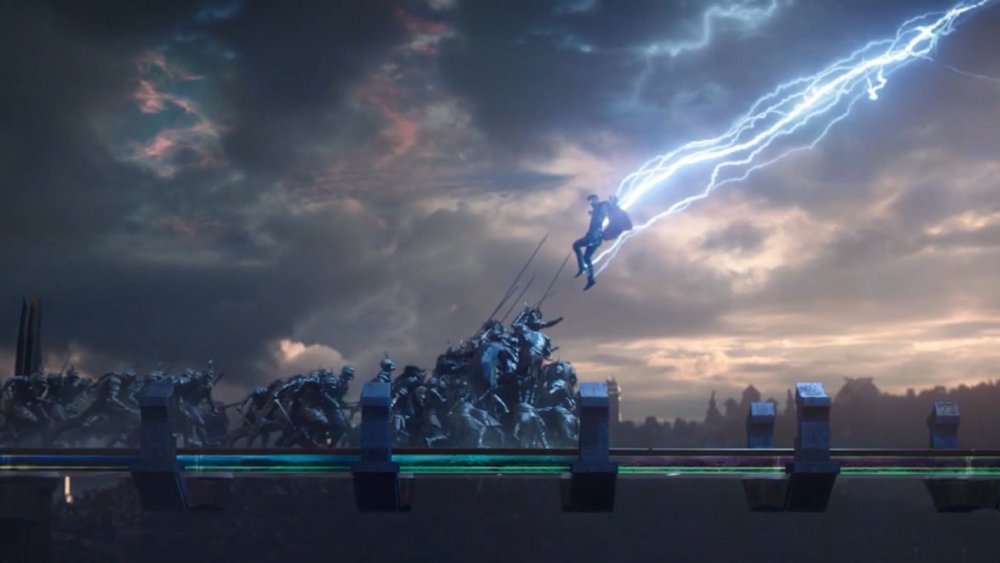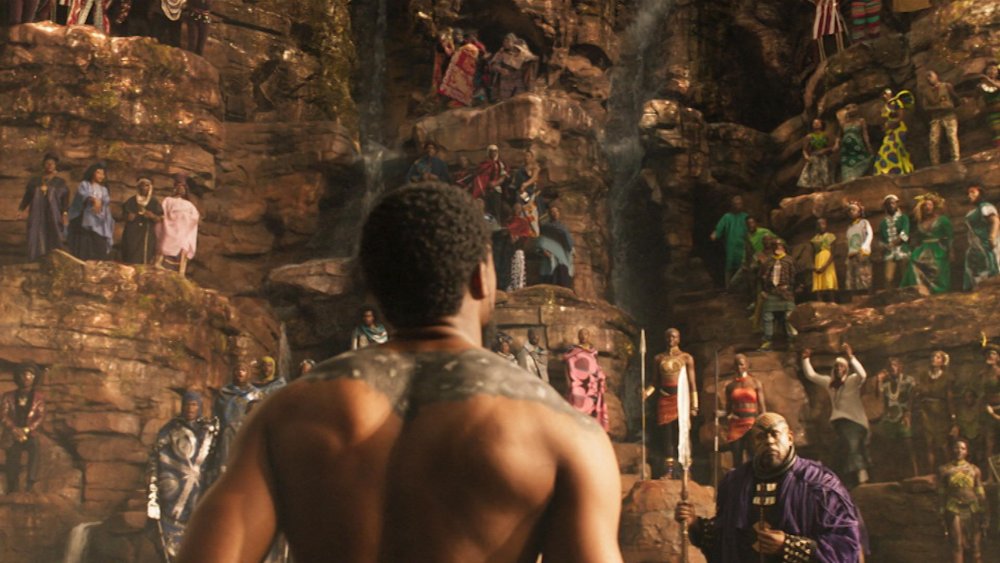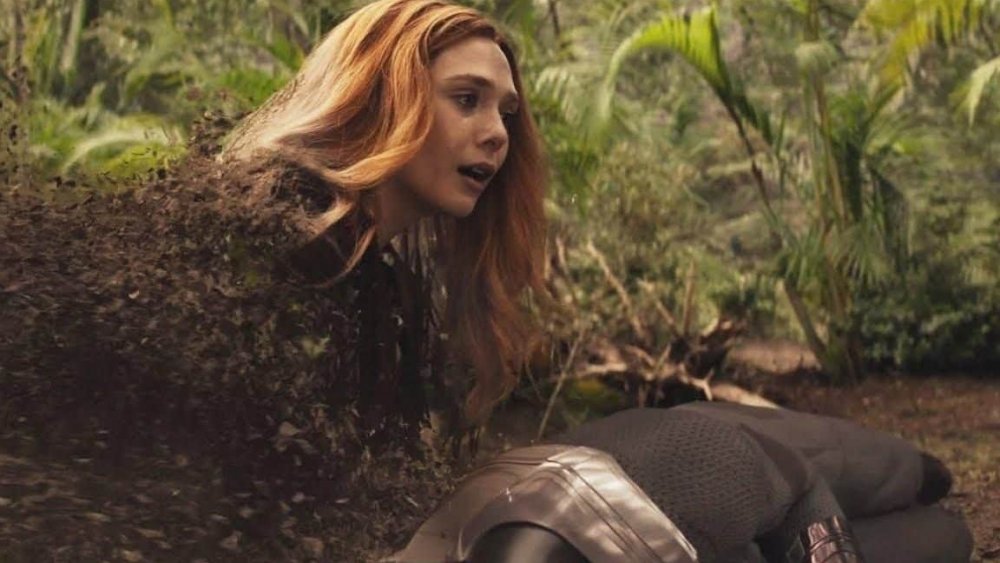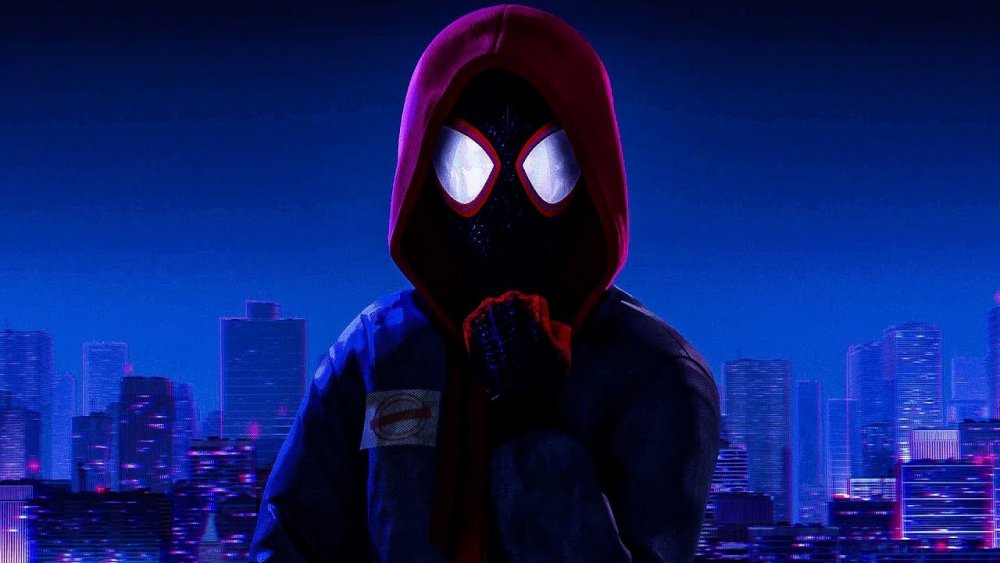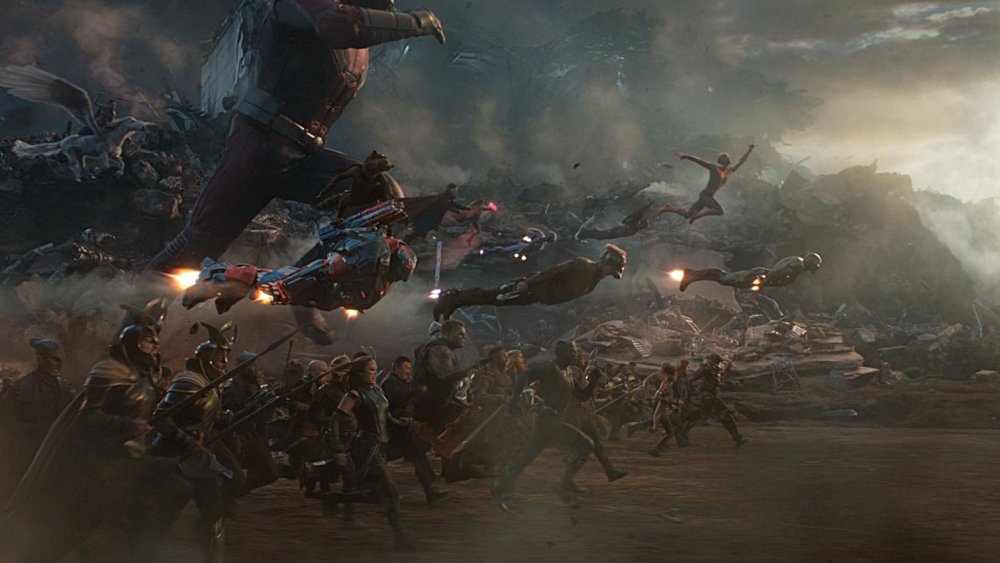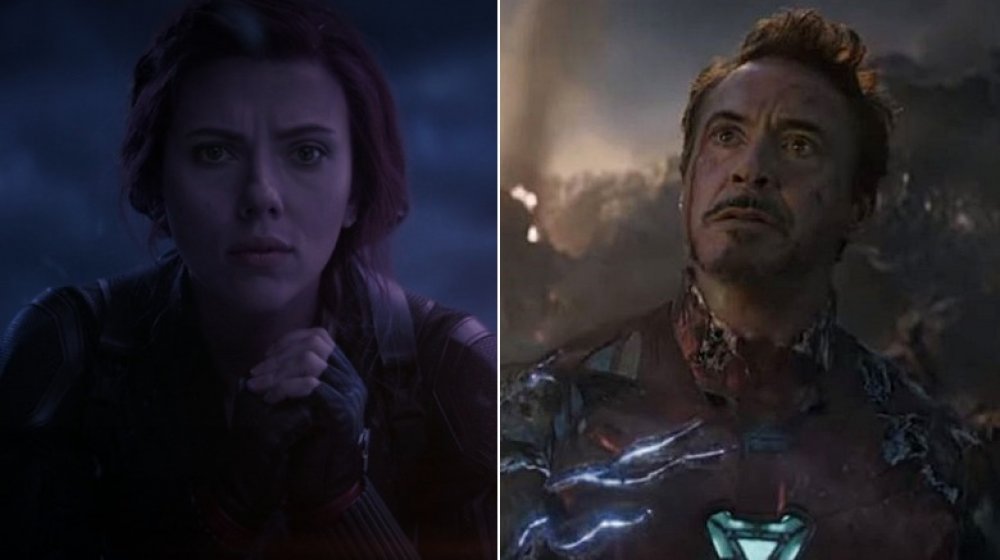The Most Iconic Superhero Moments Of The Last Decade
As long as there have been superhero movies, there have been iconic moments that have defined both individual characters and the genre as a whole, setting the bar for what we expect from a superhero movie. The 1970s had Christopher Reeve's Superman turning back time. The 1980s had Michael Keaton growling, "I'm Batman." And the 2000s had Tobey Maguire gritting his teeth as he held back a speeding train. But what about the 2010s?
Well, when it comes to incredible superhero scenes, the 2010s were absolutely full of them. After all, it was the decade of the Marvel Cinematic Universe, the DCEU, and a whole host of other awesome films about crime-fighting characters. And below, we're taking a look at some of the most iconic superhero movie moments of the last decade, unpacking what made them special and exploring the ways in which they stretched our understanding of what's possible within the superhero genre itself.
The superheroes assemble in The Avengers
It's almost hard to remember now, but back in 2012, a film like The Avengers was completely unprecedented and unfathomable. While superhero fans had long been accustomed to reading exciting events in comic books that brought together their favorite characters from across a variety of solo titles to team up against a universal threat, never before had there been a film that attempted to achieve the same thing. When it came to movies, fans had long resigned themselves to well-executed solo franchises like Sam Raimi's Spider-Man trilogy or Christopher Nolan's Dark Knight movies as being the best we could hope for.
But then came The Avengers, which brought together the lead characters from Iron Man, The Incredible Hulk, Captain America: The First Avenger, and Thor, along with a supporting character from Iron Man 2 and, well, Hawkeye. These six superheroes were brought together by Nick Fury, a character who'd been lurking in the shadows of multiple previous movies, to battle the charismatic villain from Thor, who'd returned from defeat with an alien army. After a few false starts, the team finally united in the final act of the film, fully and gloriously realized in a rotating power shot that looked just like like a comics splash page come to life. It was the moment that comics fans had never even dared to hope for, and against all odds, it worked so well that The Avengers still stands out as one of the best superhero movies of the decade.
Bruce Wayne climbs out of the pit in The Dark Knight Rises
Although 2012's The Dark Knight Rises is often considered the weakest of Christopher Nolan's Batman trilogy, it contains a few scenes that can go toe-to-toe with some of the most memorable Batman moments that have ever been put to film. The one that stands out the most takes place after a defeated and discarded Bruce Wayne (Christian Bale) refuses to accept the fate he's been dealt after having his back broken by Bane (Tom Hardy) and being cast into a subterranean prison.
Although Bruce is told that escape is impossible, he pushes himself time and time again to stretch beyond his own limits, repeatedly attempting to climb up the unforgiving rock walls of the prison to freedom. The scene in which Bruce finally succeeds in his efforts and pulls himself up out of the dark pit and into the sunlight above, to the chanting and cheers of the prisoners below and Hans Zimmer's urgently pulsing score, is easily one of the most thrilling and inspiring scenes in any Batman film. But even more than that, watching Bruce claw his way back to the life that Bane thought he'd stolen from him is a perfect illustration of the determination, ability, and grit that we expect from Batman, and it helped remind fans why the Dark Knight is one of our most beloved and enduring superheroes.
Captain America's iconic elevator fight in Captain America: The Winter Soldier
There are any number of Captain America moments you could slap the label of "iconic" on and be correct, but probably the one that best fits the bill in the MCU is Steve's (Chris Evans) claustrophobic elevator fight scene in 2014's Captain America: The Winter Soldier. After Alexander Pierce (Robert Redford) realizes that Steve is beginning to get suspicious of S.H.I.E.L.D., he sends a group of agents to subdue Steve in an elevator. But Steve, realizing what's going on before the first punch is thrown, manages to gain the upper hand, defeat all his foes, and escape by jumping a dozen stories to the ground below.
Not only is it one of the most flawless scenes in the MCU, but the elevator fight also gives us several important insights into Steve's character. We get to see Steve's deductive reasoning skills on full display as he wordlessly pieces together what's happening, and we get a glimpse of his good heart when he offers the agents a chance to exit the elevator without violence. (He doesn't even attempt to throw the first punch.) Then when Rumlow (Frank Grillo) tries to tell Steve that the attack isn't personal, Steve replies, "It feels personal," and we can hear in his tone that his feelings are legitimately hurt. The elevator fight may show us Steve in full super-soldier mode, but it also helps us see that no matter what Steve Rogers is doing, his humanity is always right there at the surface.
Quicksilver's kitchen run in X-Men: Days of Future Past
Although the X-Men are among Marvel's most iconic characters, their films have consistently struggled to do them justice. Whether it's finding the right balance of the team's massive roster or figuring out the best way to showcase their broad array of mutant powers, no X-Men film has yet been able to replicate the perfect alchemy of the comics, although some have come momentarily close. One such moment is the kitchen scene from 2014's X-Men: Days of Future Past, after Wolverine (Hugh Jackman), Professor X (James McAvoy), and Quicksilver (Evan Peters) have freed Magneto (Michael Fassbender) from his plastic prison and find themselves cornered in the kitchen by agents looking to recapture the metal manipulator.
While Logan, Charles, and Erik argue about how best to deal with the threat, Quicksilver decides to take matters into his own hands, pulling his goggles down over his eyes before zipping around the room, as Jim Croce's "Time in a Bottle" plays dreamily underneath. Previous live-action depictions of speedsters had focused on showing the characters as a quick-moving blur, but Days of Future Past takes the opposite tactic, giving us the scene from Quicksilver's point of view as everything around him moves in super slow motion. The result is equal parts comical and wondrous, and the scene has had a lasting impact on how speedsters have been portrayed on screen ever since, in everything from Avengers: Age of Ultron to the CW's The Flash.
The 'We are Groot' moment in Guardians of the Galaxy
Guardians of the Galaxy marked a pivotal moment in the formation of the MCU. Up until then, the heroes and conflicts had been fairly straightforward and grounded, with even the more cosmic-leaning plots of Thor and Thor: The Dark World contained mostly to Earth and the Norse mythology-based Asgard. But in Guardians of the Galaxy, director James Gunn exploded the possibilities for the Marvel Cinematic Universe's actual universe, introducing numerous new planets and alien species in a zany, galaxies-spanning narrative, showing that the sandbox Marvel could play in was far larger than we'd previously understood.
Guardians was also the first Marvel film to introduce an entire team, not just an individual character. Although The Avengers also featured a team, they were all previously established characters, many coming from their own individual franchises, whereas Guardians set up a family unit that we expect to always remain together. Toward the end of the film, that theme of family is solidified when the team — who's spent most of the film bickering and resisting the bonds forming between them — is threatened, and the trio-syllabic Groot takes it upon himself to save them all in a moving moment of self-sacrifice. Up until that moment, the only words we've ever heard Groot utter are, "I am Groot," which he manages to imbue with countless meanings. But when his partner and best friend, Rocket, questions his actions, Groot says tenderly, "We are Groot." His meaning is clear: The Guardians are now a family, and they belong together.
The gleefully snarky opening credits and car fight in Deadpool
From Batman and Superman to X-Men and Iron Man, audiences have been conditioned for decades to expect morally upstanding heroes who give inspiring speeches and stand firmly against the forces of evil whenever they head to the theater for a superhero movie. But while countless films have taught us to expect a certain degree of self-seriousness from superhero films, 2016's Deadpool turns that expectation on its head within its first few seconds as the opening credits take us through a three-dimensional freeze frame of the excessively violent action sequence we're about to witness, flashing descriptions such as "God's perfect idiot" and "a gratuitous cameo" across the screen as Juice Newton's "Angel of the Morning" plays underneath.
And once we get through the credits, Deadpool establishes from the first scene that this superhero film isn't going to be like anything we've seen before. Not only do we get to see the bloody circumstances that lead up to the brutal backdrop of the opening credits, but we also get introduced to Deadpool's (Ryan Reynolds) profane, irreverent, and often fourth-wall-breaking commentary as he takes out a car full of criminals in his search for the movie's villain, Francis. The foul-mouthed character had previously been so confounding for movie-makers that he'd had his mouth seared shut in X-Men Origins: Wolverine, but Deadpool showed that not only was it possible to faithfully bring the Merc with a Mouth to the big screen in all his offensive glory, but that audiences would eat it up.
The DC superheroes unite in Batman v Superman: Dawn of Justice
After witnessing the success of Marvel with The Avengers, DC decided in 2016 to try their best to replicate Marvel's formula with three of its most iconic comic characters in Batman v Superman: Dawn of Justice. The film overall was a mixed bag, with DC trying to bite off too much, too soon in its attempt at a team-up film before it had even given Batman (Ben Affleck) or Wonder Woman (Gal Gadot) their own solo outings. However, although the film's overarching conflict between Batman and Superman (Henry Cavill) fell mostly flat, its climactic showdown in which they were joined by Wonder Woman to battle comics super-baddie Doomsday gave us a glimpse of greatness.
Batman, Superman, and Wonder Woman are among some of the most popular and enduring comics characters ever created, and regardless of the faults of the movie that preceded their final battle, seeing the three of them finally join forces together on screen was nothing short of spectacular. Diana joins the game well into the fight, after Superman has already "died" and come back to life, but once she does and we finally get a momentary look at the DCEU's potential to bring the Justice League to life, it's hard not to get excited at the possibilities. Sure, the actual Justice League film stumbled in its execution, but after watching these three characters team up against Doomsday, we can't help but hope that DC will one day be able to channel that magic again.
Team Cap vs. Team Iron Man in Captain America: Civil War
While The Avengers was groundbreaking in 2012, by the time 2016 rolled around and we'd also seen Avengers: Age of Ultron and Batman v Superman: Dawn of Justice, watching established superheroes join forces against a common foe felt practically old hat. So the next step for Marvel was to take their beloved roster of superheroes and pit them against one another in a conflict that wouldn't be easily resolved by the end of the film, one that would have lasting repercussions throughout the rest of the Marvel Cinematic Universe.
Captain America: Civil War saw Marvel do the unthinkable, taking the two de facto leaders of their most successful super-team and placing them on opposite sides of a seemingly irreconcilable argument. Gradually throughout the first half of the film, both Captain America and Iron Man (Robert Downey Jr.) recruit the team from Age of Ultron (along with a few new members) to either of their opposing sides, each passionately arguing his own point and persuading both the characters and the audience with their disparate ideologies. It all comes to a head in the airport scene, which sees the two groups of former friends and teammates take each other on in superpowered battle. It's the rare superhero fight where there are no "bad guys" or obvious right answers, and as such, we find ourselves kind of rooting for everyone. It broke new ground in superhero films, and it still stands as one of the most epic fight scenes of the century and one of the most memorable superhero scenes ever.
Diana crosses No Man's Land in Wonder Woman
Although women have been part of superhero movies and teams for years and had occasionally even received their own solo movies in films like Elektra and Catwoman, it wasn't until Patty Jenkins' Wonder Woman in 2017 that a female superhero finally got her due. From the opening scene of the Amazons training on Themyscira, women were crying in the theater during Wonder Woman's action scenes, unexpectedly moved to see women in a major comic book movie depicted as just as strong, noble, brave, and skilled as any male hero in other films.
While Wonder Woman contains no shortage of scenes that beautifully and powerfully showcase Diana's character and abilities, no sequence does it better than the one in which she climbs out of a foxhole to cross a battlefield and save an enslaved village. After being discouraged by Steve Trevor (Chris Pine), who insists that she can't save everyone and that getting across "No Man's Land" is impossible, Diana lets her hair down, drops her cloak, and single-handedly pushes her way across the battlefield, breaking into a run as she draws enemy fire and deflects bullets, clearing the way for the troops behind her. Diana's determined charge across No Man's Land accomplished what Steve insisted no man was capable of doing, cementing her as one of our most iconic modern superheroes of any gender.
The death of Wolverine in Logan
After Deadpool opened the door for adult-oriented, R-rated cinematic versions of classic Marvel superheroes, 2017's Logan gave us a much more somber take on a not-for-kids superhero tale. Based loosely on the post-apocalyptic comic Old Man Logan, Logan followed an aged future version of Wolverine caring for an ailing Charles Xavier (Patrick Stewart) following the destruction of most of the rest of mutantkind. Hugh Jackman had been playing the character ever since 2000's X-Men, appearing in seven X-Men films before finally bringing Wolverine's story to an end in Logan.
One of Logan's defining characteristics is his ability to heal from almost any injury, making him nearly ageless and practically immortal, a characteristic that comprised a major plot point in previous films. But Logan sees his mutant healing ability finally compromised after years of fending off adamantium poisoning from his metal skeleton, and he spends most of the film visibly struggling as his body destroys itself from the inside. The film's final act sees Wolverine cut down by a younger, cloned version of himself as Logan desperately attempts to protect Laura (Dafne Keen), a child who was created from his DNA. Logan dies holding Laura's hand, sacrificing himself out of love for another and closing the cinematic book on one of Marvel's most enduring superheroes. By killing Wolverine, Logan helped raise the stakes for the superhero genre as a whole and taught audiences that even in the world of superhero films, nothing lasts forever.
The Revengers take on Hela in Thor: Ragnarok
Effectively soft-rebooting the (self-proclaimed) strongest Avenger, Thor: Ragnarok changed the MCU by taking a mostly stodgy character and his somewhat boring world and giving them a makeover. The film introduced a Thor (Chris Hemsworth) and an Asgard that were far more fun, funny, and weird than any of their previous iterations. Director Taika Waititi redefined everything we'd come to expect from a Thor story, ruthlessly tossing out the elements that didn't fit with his wacky vision, crushing Thor's hammer, taking his eye, and destroying all of Asgard in the process.
In Ragnarok's final battle, Thor, Loki (Tom Hiddleston), Valkyrie (Tessa Thompson), and the Hulk (Mark Ruffalo) team up as the self-dubbed "Revengers" to make their final stand against Hela (Cate Blanchett), the Goddess of Death. Nine years into the MCU, fans thought we knew what to expect from a Marvel action scene, but Ragnarok shook up our sensibilities once again, blasting Led Zeppelin's "Immigrant Song" underneath a technicolor fight sequence that felt like equal parts classic comic book splash page and '80s heavy metal music video, and ending surprisingly with the characters deciding to abandon Asgard to destruction in the name of the greater good. Probably one of the most stunning sequences in the MCU, Ragnarok's "Immigrant Song" scene not only delivered a super entertaining and memorable battle, but it shifted the paradigm for the MCU as a whole with its willingness to scorch earth — or in this case, space — and start over.
T'Challa's majestic coronation in Black Panther
After first being introduced in Captain America: Civil War, the character of T'Challa (Chadwick Boseman) finally took center stage in 2018's Black Panther, which sees Wakanda's new ruler face his greatest challenge yet in the form of one of the African nation's forgotten sons. Never before had a mainstream superhero film so lovingly embraced a cast of almost entirely black characters. Plus, the movie featured an African setting and various indigenous cultures with nuance and respect. Black Panther was also the first Marvel film to truly dig into meaty social commentary, with the ideological conflict between T'Challa and Erik Killmonger (Michael B. Jordan) rooted in a history of racial oppression.
However, before Black Panther really sinks its teeth into the clash between T'Challa and Killmonger, it takes its time to first establish and celebrate the kingdom of Wakanda, as the various tribes of the region assemble for T'Challa's coronation. The scene is notable for many reasons, from the stunning backdrop of the stopped waterfall and the driving drums of the rhythmic score to the vibrantly colored costumes and intricate face paint of the gathered tribes. Although the kingdom of Wakanda is fictional, the scene pays homage to a number of very real African cultures, many of whom have never been so respectfully represented before in a mainstream movie. It was a landmark moment not just within the MCU, but also in the push for more positive representation for marginalized communities within film in general.
The devastating snap in Avengers: Infinity War
Going into Avengers: Infinity War, the first of the two event films that would close out the "Infinity Saga," fans were expecting a higher body count than usual. We knew that central actors Chris Evans and Robert Downey Jr. were approaching the ends of their contracts, and we figured that the time may have come for us to actually lose one or two of our main heroes. We thought we were braced for whatever Infinity War had in store for us. After all, comic books kill major characters all the time, and it was about time that the movies followed suit.
However, as much as we thought we were prepared, no one saw the ending of Avengers: Infinity War coming. Not so much a bloodbath as a dustbath, Infinity War sees the Avengers defeated by Thanos (Josh Brolin), who completes his mission to collect the six Infinity Stones, snap his fingers, and wipe out half of all life in the universe — including far more than half of the superheroes we'd come to know and love. Spider-Man (Tom Holland), Doctor Strange (Benedict Cumberbatch), Star-Lord (Chris Pratt), Scarlet Witch (Elizabeth Olsen), Black Panther, and more all turn to dust before our eyes, fading to nothing as the surviving heroes can do nothing but watch. It was totally unexpected, the sort of loss we didn't even think was possible in a kid-friendly superhero film, and it blew open the possibilities for where superhero movies can go from here.
Miles' big moment in Spider-Man: Into the Spider-Verse
After six Spider-Man solo movies and three different versions of Peter Parker, webslinger fatigue had become a pretty real condition by the time Spider-Man: Into the Spider-Verse swung into theaters in 2018. But although the animated film gave us a few more takes on Peter, nothing about Spider-Verse felt tired or familiar, and not just because the animated format allowed for a different type of storytelling. The most obvious way that Spider-Verse stood out is in its main character — half-black, half-Latino teenager Miles Morales — who gained abilities such as super-strength, super-stickiness, and super-spider-sense after being bitten by a radioactive spider.
That much sounds like Peter's origin story, but that's where the similarities end. Spider-Verse sees the familiar version of Peter killed early on, with a washed-up, burned-out version then taking his place to help train Miles. It's evident in the earliest scenes of Spider-Verse that Peter isn't the star here. Instead, Miles is. And although it takes Miles a while to decide to embrace his destiny as Spider-Man, once he does, it's in one of the best taking-on-the-mantle sequences to have ever been put to film, as Miles pulls on the Spider-Man cowl under his hoodie, plummets off a skyscraper, and then swings triumphantly through the streets of New York, all as Blackway & Black Caviar's original track "What's Up Danger" grooves underneath. It's an invigorating and visually arresting sequence, notable for how well it works within the movie itself, and how much it stands out in the genre overall.
The biggest battle of the decade in Avengers: Endgame
First Marvel brought a team together in The Avengers, then it split them up in Captain America: Civil War, then reunited them again in Avengers: Infinity War, only to kill off most of them by the end. By the time Avengers: Endgame rolled around, audiences had no idea what to expect from the MCU anymore, after being convinced that no character was off-limits and no stakes were too high. All we knew was that Endgame promised to be the biggest, most epic superhero film we'd ever seen. And boy, did it ever deliver.
Endgame knew the weight of the responsibility it carried, and it largely delivered, with most of its first two acts serving as both a thrilling narrative all on its own and a love letter to the fans who'd been with the franchise since the beginning. But it was the ending that finally gave us an event over a decade in the making, as nearly every major character from every single Marvel movie joined together on the ruins of the Avengers compound after the original six Avengers used the Infinity Stones to bring back those they'd lost. Emerging from countless portals created by Doctor Strange, the Masters of the Mystic Arts, Asgardian troops, the Ravagers, and the heroes who'd fallen at the end of Infinity War returned to make a united, spectacular final stand against Thanos, as Captain America finally delivered his long-awaited line: "Avengers, assemble."
The deaths of two iconic superheroes in Avengers: Endgame
Despite Avengers: Infinity War teaching us that no hero's life is sacred and that anyone can fall in the fight for the greater good, it still came as a devastating blow when Avengers: Endgame took the lives of not one but two founding Avengers. As soon as Natasha Romanoff (Scarlett Johansson) accompanied Clint Barton (Jeremy Renner) to Vormir to retrieve the Soul Stone, we had a bad feeling, knowing the price that Thanos had to pay for the stone in Infinity War. Sure enough, the two old friends wound up duking it out on the cliffs of Vormir, each trying to save the other from making the ultimate sacrifice. Natasha ultimately prevailed, falling to her death and leaving a grieving Clint to leave alone with the stone.
Her sacrifice is what enabled Bruce Banner to snap his fingers and resurrect everyone who'd been snapped away in Infinity War ... and also allowed Tony Stark to win the battle against Thanos, at the cost of his own life. Seizing the one-in-14-million chance of success Doctor Strange had given him, Tony took the stones from Thanos long enough to snap the Mad Titan and his armies out of existence, but the energy it used was too much for his human body to take, and Tony died shortly thereafter. As the hero who kicked off the entire MCU, the death of Tony Stark was a major blow to both the surviving Avengers and to the fans who'd followed him for so long, and we expect that we'll all be feeling Tony and Natasha's deaths for a long time to come.
